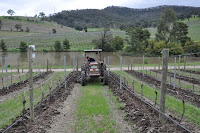If the soil’s pH level is too acidic, ground limestone can be applied to the acidic soil to reach a more desirable pH level (neutral to slightly alkaline soil is good for grape growing).
Additional nutrients and fertilizers like phosphorous should be added to the soil only after the careful measurement of the soil’s chemical properties.
For example, if the phosphorous level of the soil is already at the 300 pounds/acre level, the addition of phosphorous should be reduced.
Inversely, lands with low mineral levels detected during soil sampling will require additional fertilizers and minerals before planting to bring the nutrient level up to a more acceptable range.
According to guidelines from the USDA, if the soil in question has been proven to have 1,600 pounds/acre or more of phosphorous, no additional phosphorous should be added to the soil for any reason.
Careful consideration should also be given to land areas that are in close proximity to natural bodies of water such as streams and rivers, because agricultural runoff can affect the quality of the water and may produce long-term problems for the soil and the natural waterway.
Consult with your local state board for agriculture before adding fertilizers and other chemicals to your land and follow the state board’s guidelines.
If you already have viable land for a new vineyard, you can take a representative sample of the land’s soil to an agricultural laboratory or experimental station for analysis.
A core sample can be obtained by digging up to seven inches into the soil. For non-traditional vineyard areas like lawns, you can reduce the depth to about four inches. It is recommended that vineyard owners perform a soil analysis of their land every two years.


0 comments:
Post a Comment